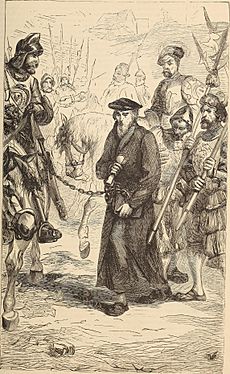Jerome of Prague facts for kids
Quick facts for kids
Jerome of Prague
|
|
|---|---|
16th century Engraving of Jerome of Prague from Theodore Beza's Icones
|
|
| Born | 1379 |
| Died | 30 May 1416 (aged 36–37) Konstanz, Bishopric of Constance, Holy Roman Empire
|
| Education | University of Prague Oxford University |
| Occupation | |
|
Notable work
|
|
| Theological work | |
| Era | Bohemian Reformation |
Jerome of Prague (in Czech: Jeroným Pražský; in Latin: Hieronymus Pragensis; 1379 – 30 May 1416) was a smart philosopher, a theologian (someone who studies religion), a reformer, and a professor from Bohemia. He was a main supporter of Jan Hus and was later executed for his beliefs at the Council of Constance.
Contents
Jerome's Early Life and Education
Jerome was born in Prague, which is now part of the Czech Republic, in 1379. He finished his studies at the Charles University of Prague in 1398. Later, he went to Oxford University in England. There, he learned about the ideas of John Wycliffe, who was a church reformer.
Jerome was a very educated person. He spent much of his life traveling to different universities. He taught in places like Paris, Cologne, and Heidelberg. However, he often faced accusations because of his strong opinions. He believed that some church teachings were not right. He wanted to change these ideas.
He was known for being a great speaker. His words could often get people excited and lead to public protests against the church. In 1402, he visited England again. At Oxford, he copied some of John Wycliffe's important books. This showed his deep interest in Wycliffe's reform ideas.
Jerome was always getting into trouble for his views. In 1410, he spoke in favor of Wycliffe's ideas. This speech was later used against him at the Council of Constance. He was even put in prison in Vienna for supporting Wycliffe's writings, but he managed to escape.
Jerome's Teachings and Beliefs
Jerome taught some very bold ideas about the Roman Catholic Church. He believed that people could understand God's teachings directly. They did not always need the church or its leaders to guide them. He taught that Christians should follow Jesus's direct words, even if they disagreed with the church's rules.
He was a strong follower of both John Wycliffe and Jan Hus. Because his teachings were different from the official church views, he was often on the move, trying to avoid being caught by authorities. Jan Hus was a mentor to Jerome, even though Hus had a calmer way of doing things.
Jerome often started public demonstrations in cities like Paris, Vienna, and Prague. Many of these protests happened in university towns where he taught. Teaching at universities helped Jerome share his ideas with many students and people. In Kraków, he was questioned about his acceptance of Wycliffe's ideas. He said he disagreed with the general meaning of the accusations against Wycliffe.
Jerome's Trial and Execution
In 1414, Jan Hus went to the Council of Constance. Jerome promised Hus that he would come to help if needed, even though Hus told him not to. When Hus arrived, he was arrested and put in prison. Jerome kept his promise and arrived in Constance on April 4, 1415. His arrival caused a lot of attention in the town.
Jerome's friends convinced him to go back home to Bohemia. But on his way, he was arrested on April 20 and taken to Sulzbach. He was then brought back to Constance on May 23. He was immediately accused of trying to escape from the council.
He was given two days to admit his supposed mistakes. After that, on May 30, 1416, the council decided he was a heretic (someone whose religious beliefs are against official church teachings). He was then sentenced to be burned at the stake.

His punishment was decided because he openly accepted Wycliffe's ideas, especially about the Eucharist (a Christian ceremony). He also openly admired Jan Hus and his teachings. Jerome refused to change his beliefs. The council tried to make him give up his ideas while he was in prison.
In public meetings on September 11 and 23, 1415, Jerome did say he would give up his "heresies" and rejected Wycliffe and Hus. He even wrote letters saying that Hus had been rightly burned for his beliefs (Hus had been executed while Jerome was in prison). However, he remained in prison because the council doubted if he was truly sincere.
On May 23 and May 26, 1416, he was brought before the council again. On the second day, he took back his earlier statement. Because he went back to his original beliefs, he was again found to be a heretic. The council then handed him over to the authorities to be burned. Later, Jerome was seen as a martyr (someone who dies for their beliefs) by followers of Jan Hus and by Protestants in the 1500s.
See also
 In Spanish: Jerónimo de Praga para niños
In Spanish: Jerónimo de Praga para niños



